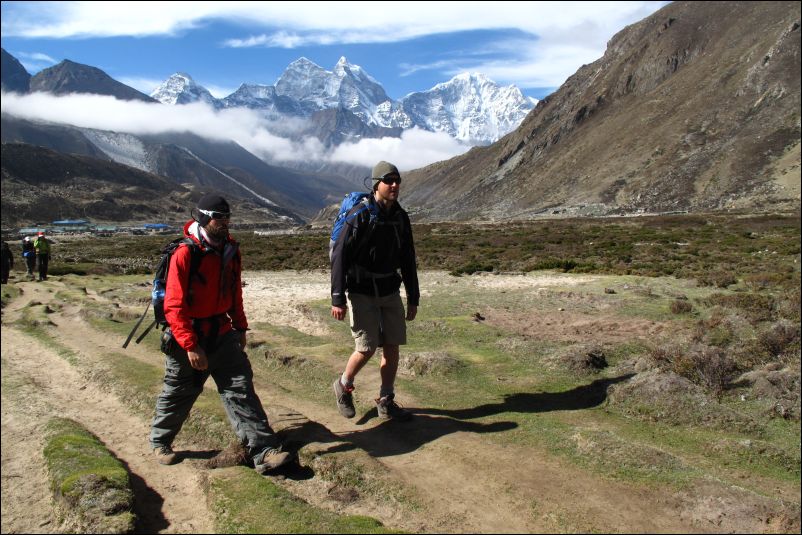Guide For Successfully Trekking to Everest Base Camp
Trekking to Everest Base Camp is easier than climbing to the summit of Mount Kilimanjaro, but that doesn’t mean you take EBC for granted.
EBC is lower, 17,585 feet compared to Kilimanjaro’s 19,341 feet and that makes a big acclimatization difference. You don’t camp out on your trek, instead you stay in small comfortable lodges in the five Himalayan hamlets en route to EBC. You will sleep better and eat carefully prepared Tusker cuisine.
That doesn’t mean you can doze off in your preparations for this trip. Even though over 95 percent of Tusker’s trekkers make it successfully to Base Camp, don’t underestimate this trek. It is strenuous with altitude, weather and health challenges. To be successful you will need to have the right gear, the right mindset and be in primo shape.
Start training now
Even though you are not backpacking to Everest Base Camp it is a hard trek where you will be on your feet for 70 hours over 14 days on narrow mountain trails. Trails can be muddy, rocky and snowy with as much uphill as downhill traversing even when you have reached high altitude.
“Every day is hard and it’s not easy after you reach base camp. If you mentally tell yourself that you’re done after you’ve made it to base camp, the hike down will be tough,” guide Mel Kaida warns. “You need to be physically prepared for uneven terrain, rocky angled trails that adds to fatigue especially for those who just work out in gyms, treadmills and ellipticals. Try to train outside at least once a week to let your muscles and feet get use to walking on uneven surfaces.”
Find a rocky trail in your area and walk it frequently in the months before your trip. Do it in cold weather as temperatures at EBC often dip into the 30’s. Get yourself in peak aerobic shape, lose the baby fat and be in 100 percent health when you board your flight for Kathmandu. You don’t want to arrive with a compromised immune system.
For Nepal special muscles need to be developed especially for women. Bathroom breaks on the trek can be challenging as toilets are basic, often a porcelain lined hole that requires squatting. “Ladies get those squatty muscles in shape and when they are primed it makes the bathroom experience easier,” Mel says.
Gear up
You will need a large daypack for the trek to Everest Base Camp so consider investing in a top of the line 36 liter Osprey that contains a hydration bladder slot with pouches on the waist strap. It must fit well, so walk around the store before purchasing then wear it on multiple day trips in the mountains before the trip. Fit is critical, so you must travel with confidence knowing your pack fits as well as your boots. The waist strap should allow easy access to Chapstick, hand sanitizers and energy snacks – all EBC trail essentials. Make sure your pack comes with a rain cover and if it doesn’t buy a separate one to insure your pack remains dry. Rain at lower elevation and snow above 12,000 feet are a distinct probability.
Boots are always the most important piece of equipment on a Tusker trek. A mid-weight boot that is water proof should work. Ankle support is key so find a boot that gives ample support to your Achilles tendon and ankle. Make sure they are well broken in and worn on multiple hikes before arriving in Kathmandu. If the boots you took on your Kilimanjaro climb are still suportive then bring them.
Clothing: Layered and adjustable
Getting to EBC is far less austere than the arctic conditions that Everest summiteers encounter. That doesn’t mean it doesn’t get cold – once above 12,000 feet – so you must pack a warm sweater, jacket, gloves wool socks and a tight fitting wool beanie to keep your head covered.
Getting to EBC is really two trips in one. The lower elevations can be reasonably warm with some days a light long sleeve shirt being your outer layer. Once above 10,000 feet it’s essential to layer with an inner, middle and outer shell. Leave the cotton at home and upgrade to wool and poly synthetics. Your big outer shell should be water proof, have a hood and be able to keep you warm in 20 degree temps.
Doctor’s orders
The biggest medical issues trekkers face on the EBC journey are altitude, stomach bugs and the dreaded Khumbu cough. Tusker veterans know the altitude drill. Allow your body to acclimatize by walking slow, hydrating often, eating often and letting your guides know how you are feeling. You can’t hide altitude sickness so if you start feeling headaches or nausea let the highly trained Tusker guides know.
If you are prone to altitude sickness consider taking Diamox. Consult your doctor and learn how to use this drug that has helped many hikers cope with high altitude. Many trekkers in the Himalaya get the dreaded Delhi Belly. Tusker brings a long our own cooking team that prepares all your food while on the trek to prevent it, however if you get to Kathmandu before the trek be careful where you dine. Don’t opt for street food, better to spend a few more rupees at an upscale restaurant and not take the chance of getting a stomach bug.



